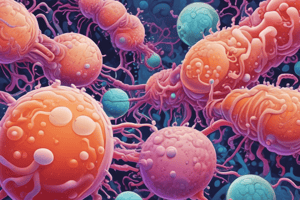Podcast
Questions and Answers
Which of the following virulence factors is associated with Staphylococcus aureus?
Which of the following virulence factors is associated with Staphylococcus aureus?
- Lactose
- Capsule (correct)
- Hyaluronidase (correct)
- Protein A (correct)
What is the common disease caused by Staphylococcus saprophyticus?
What is the common disease caused by Staphylococcus saprophyticus?
Urinary tract infection (UTI)
Staphylococcus epidermidis is catalase negative.
Staphylococcus epidermidis is catalase negative.
False (B)
Match the following bacteria with their characteristics:
Match the following bacteria with their characteristics:
The virulence factor that allows Staphylococcus aureus to evade the immune response is _____.
The virulence factor that allows Staphylococcus aureus to evade the immune response is _____.
Streptococcus pyogenes causes scalded skin syndrome.
Streptococcus pyogenes causes scalded skin syndrome.
What test differentiates Staphylococcus saprophyticus from other Staphylococci?
What test differentiates Staphylococcus saprophyticus from other Staphylococci?
Which of the following tests is used for Streptococcus pneumoniae?
Which of the following tests is used for Streptococcus pneumoniae?
The organization of Corynebacterium diphtheriae appears similar to _____.
The organization of Corynebacterium diphtheriae appears similar to _____.
What significant disease is associated with Pasteurella multocida?
What significant disease is associated with Pasteurella multocida?
What is the appearance of Mycoplasma pneumoniae colonies?
What is the appearance of Mycoplasma pneumoniae colonies?
Ureaplasma urealyticum is commonly found in pregnancy-related complications.
Ureaplasma urealyticum is commonly found in pregnancy-related complications.
What characterizes primary syphilis?
What characterizes primary syphilis?
Which of the following are symptoms of secondary syphilis?
Which of the following are symptoms of secondary syphilis?
In congenital syphilis, the tibia shows __________.
In congenital syphilis, the tibia shows __________.
Match the following spirochetes with their associated diseases:
Match the following spirochetes with their associated diseases:
Which of the following is a characteristic of Bartonella?
Which of the following is a characteristic of Bartonella?
What disease is associated with Bartonella bacilliformis?
What disease is associated with Bartonella bacilliformis?
Neisseria gonorrhea is the most commonly reported STI.
Neisseria gonorrhea is the most commonly reported STI.
C. jejuni and C. coli are known to cause _______.
C. jejuni and C. coli are known to cause _______.
What is the common test for Mycobacterium tuberculosis?
What is the common test for Mycobacterium tuberculosis?
Mycoplasmas are cell wall-deficient bacteria.
Mycoplasmas are cell wall-deficient bacteria.
What is a common characteristic of anaerobic bacteria?
What is a common characteristic of anaerobic bacteria?
What is the primary disease caused by Rickettsia rickettsii?
What is the primary disease caused by Rickettsia rickettsii?
The test for ________ is often used to determine the presence of tuberculosis.
The test for ________ is often used to determine the presence of tuberculosis.
Which of the following mycobacterial species is associated with leprosy?
Which of the following mycobacterial species is associated with leprosy?
Study Notes
CATALASE POSITIVE, GRAM-POSITIVE COCCI
- Staphylococcus aureus:
- Characteristics: Gram + cocci in clusters with PMN cells, grape-like clusters, staphyloxanthin (yellow or golden on BA)
- Diseases: Toxic shock syndrome, Scalded skin syndrome, Septic arthritis, Nosocomial pneumonia, Acute endocarditis
- Diagnostic tests: Catalase+, Coagulase+, b-hemolytic, PENICILLIN resistant, b-lactamase+
- Staphylococcus epidermidis:
- Characteristics: Small-medium, opaque, gray white colonies, slime-producing strains are extremely sticky
- Diseases: Prosthetic valve endocarditis
- Diagnostic tests: Catalase+, Coagulase-, Novobiocin sensitive
- Staphylococcus saprophyticus:
- Characteristics: Large, entire, very glossy, smooth, opaque, butyrous, convex colonies
- Diseases: UTI in young females
- Diagnostic tests: Catalase+, Coagulase-, Novobiocin resistant
- Staphylococcus lugdunensis:
- Diseases: Dog bite wound infections
- Staphylococcus scheliferi:
- No notable diseases or characteristics mentioned
CATALASE NEGATIVE, GRAM-POSITIVE COCCI
- Streptococcus pyogenes (Group A):
- Characteristics: Gram + cocci in chains, round to oval shaped, occasionally forming elongated cells
- Diseases: Scarlet fever, Rheumatic fever, Necrotizing fasciitis, Pharyngitis
- Diagnostic tests: Catalase-, b-hemolytic, Bacitracin sensitive
- Streptococcus agalactiae (Group B):
- Characteristics: Capsule (most important virulence factor), grayish-white mucoid colonies surrounded by a small zone of β-hemolysis
- Diseases: Pneumonia, Neonatal infections
- Diagnostic tests: Catalase-, b-hemolytic, Bacitracin resistant, PYR-, CAMP+
- Streptococcus pneumoniae:
- Characteristics: Round, glistening, wet, mucoid, dome-shaped appearance
- Diseases: Leading cause of bacterial meningitis, Pneumonia
- Diagnostic tests: Catalase-, A-hemolytic, Bile solubility S, Optochin S, Quellung+
- Enterococcus (Group D):
- a. Enterococcus faecalis:
- Diseases: UTI, Bacteremia, Endocarditis
- Diagnostic tests: PYR+, 6.5% NaCl growth, LAP+, Cephalosporins, aminoglycosides resistant
- b. Enterococcus faecium:
- Diseases: UTI, Bacteremia, Endocarditis
- Diagnostic tests: PYR+, 6.5% NaCl growth, LAP+, Cephalosporins, aminoglycosides resistant
- a. Enterococcus faecalis:
CATALASE POSITIVE, NON-BRANCHING, GRAM-POSITIVE BACILLI
- Bacillus anthracis:
- Characteristics: Spore-forming rods, large, in singles, pairs or serpentine chains, gray, flat, irregular swirling projections, "comet tails" or Medusa Head
- Diseases: Cutaneous anthrax, Gastrointestinal anthrax, Inhalation anthrax
- Bacillus cereus:
- Characteristics: Spore-forming rods, large, in singles, pairs or serpentine chains
- Diseases: Food poisoning (diarrhea and abdominal pain)
- Toxins: Hemolysin BL, Nonhemolytic enterotoxin, Cytotoxin K, Cereulide
LISTERIA, CORYNEBACTERIUM, AND SIMILAR ORGANISMS
- Listeria monocytogenes:
- Characteristics: Non-spore forming, short rod, occurs singly or short chains, end-over-end tumbling motility, umbrella-shaped pattern
- Diseases: Listeriosis, Stillbirth
- Diagnostic tests: Catalase-, VP+, CAMP+, Esculin+, PCR, Elek Test
CATALASE NEGATIVE, NON-BRANCHING, GRAM-POSITIVE BACILLI
- Erysipelothrix spp:
- Characteristics: Short rods and long filaments, "bottle brush" appearance, delicate, curved, rods with pointed ends, occasional rudimentary branching
- Diseases: Cellulitis (erysipeloid), Pharyngitis
BRANCHING OR PARTIALLY ACID-FAST, GRAM-POSITIVE BACILLI
- Nocardia asteroides:
- Characteristics: Beaded appearance, pleomorphic, dry and heaped colonies, soil or musty basement odor
- Diseases: Pulmonary (immunocompromised)
- Diagnostic tests: Catalase+, Acid Fast (V)
GRAM-NEGATIVE BACILLI AND COCCOBACILLI
- Escherichia coli:
- Characteristics: Greenish metallic sheen on EMB or MAC, Pili
- Diseases: UTI, Watery diarrhea, Hemorrhagic colitis, HUS
- Diagnostic tests: IMViC: ++ – -, Lactose+, Oxidase-
- Shigella:
- Characteristics: Bacillary dysentery, Fever, Watery then bloody diarrhea
- Diseases: Bacillary dysentery
- Diagnostic tests: Lactose-, H2S+, Lysine+, Indole-
(Many more organisms and diseases listed in the original text, but I've condensed it to highlight the key points and characteristics of each organism.)### Burkholderia Complex
- Not part of normal microbiota
- Can cause severe infections in patients with cystic fibrosis or chronic granulomatous disease (CGD)
- Burkholderia cepacia complex:
- Can survive in human macrophages
- Causes melioidosis
- Burkholderia mallei:
- Causes glanders in horses and related animals
- Bipolar staining
- Burkholderia pseudomallei:
- Causes melioidosis
- Can cause pneumonia, particularly ventilator-acquired pneumonia
- Obligate aerobe
- Oxidase positive
- Produces pyocyanin, pyoverdin, and pyorubrin
Pseudomonas spp.
- Can form biofilms
- Can cause pneumonia, particularly ventilator-acquired pneumonia
- Third most common cause of nosocomial urinary tract infections
- Associated with disrupted epidermis, cystic fibrosis, and immunocompromised patients
- Oxidase positive
- Produces pyocyanin (blue phenazine pigment)
- Virulence factors:
- Exotoxin A
- Exoenzyme S and C
- Proteolytic enzymes (elastases)
- Hemolysis (phospholipase C)
- Pili and adhesins
- Alginate
- Pyocyanin
- Catalases
Alcaligenes
- Strict aerobic rods
- Can cause bacteremia, ocular infections, pancreatic abscess, bone infection, and urinary tract infections
- Catalase positive
- Oxidase positive
- Motile (1-12 peritrichous flagella)
- Non-glucose utilizer
Vibrio
- Straight or slightly curved rods
- Rapid or darting shooting-star motility
- Oxidase positive
- Glucose fermenter
- Can cause cholera, bacteremia, septicemia, and gastroenteritis
- Virulence factors:
- Cholera toxin
- Toxin coregulated pili
- Zona occludens toxin
- V. cholerae O1 and O139
Aeromonas spp.
- Straight rods with rounded ends or coccobacilli
- Can cause gastroenteritis in children
- Can cause severe watery diarrhea and hemolytic uremic syndrome (HUS)
- Contains no or little WBC
- Facultative anaerobe
- Modified CIN (cefinase, indole, and nitrate reduction) test
Chromobacterium violaceum
- Straight rods with rounded ends
- Produces violet pigment (violacein)
- Facultative anaerobe
- Can cause severe infections from human bites or clenched fist wounds
- Assacharolytic
- Oxidase positive
- Catalase negative
- Reduces nitrate to nitrite
- Hydrolyzes ornithine and lysine### Bacterial Characteristics
- Helicobacter pylori: Curved, helical or spiral, microaerophilic, small, translucent, circular colonies, produces urease, motile, urea breath test positive.
Legionella
- Mesophilic (20-45°C), oblige aerobic, faintly staining, thin, fastidious, small, filamentous, multiply within amoeba, motile, extrapulmonary.
Brucella
- Small coccobacilli, resemble fine grains of sand, catalase+, urease+, oxidase+, most strains are, hydrolyze urea, relative ability to produce H2S, titer of 1:160.
Bordetella
- Minute, faintly staining coccobacilli, small and shiny, resembling mercury drops, facultative, direct fluorescent antibody test, whole cell agglutination reactions.
Francisella
- Strict aerobes, transparent, mucoid, easily emulsified, "rabbits", tularemia, rabbit fever, deer fly fever, market man's disease, carbohydrate fermenter.
Streptobacillus moniliformis
- Facultative, nonaerobe, pleomorhic, long, tangled chains and filaments with bulbar swelling, "fried egg" appearance, nonmotile, urea-, lysine decarboxylase-.
Spirillum minus
- Gram-negative, helical, strictly aerobic, thick, spiral, with 2 or 3 coils and polytrichous polar flagella, rat-bite fever, Asia: sodoku.
Neisseria
- Diplococci with adjacent sides flattened, diplococci inside PMNs, "kidney- or coffee bean-shaped", oxidase+, sexually transmitted.
Anaerobic Bacteriology
- Strict anaerobes (0% oxygen), aerotolerant organisms (5% oxygen), foul odor, sulfur granules, brick red fluorescence under long wavelength UV light.
Clostridia
- Obligately anaerobe (or aerotolerant), produces yellow, ground glass colonies, chartreuse fluorescence upon exposure to UV light, horse stable odor, botulism, tetanus.
Gram-Positive, Non-Spore Forming Bacilli
- Eggerthella and Paraeggerthella: gram-positive filaments when crushed, "sulfur granules", periodontal disease, bacterial vaginosis.
Gram-Negative Rods
- Bacteroides fragilis group: mucosal surfaces of the human oral cavity and GIT, saccharolytic, bile resistant, nonpigmented, kanamycin resistant.
Anaerobic Gram-Positive and Gram-Negative Cocci
- Peptostreptococcus anaerobius and Parvimonas micra: gram-positive cocci vancomycin sensitive, colistin resistant, gram-negative cocci vancomycin resistant.
Mycobacterium
- Mycobacterium tuberculosis complex: primary TB, meningeal or military TB, latent TB, reactivation TB, tuberculin skin test or purified protein derivative test (PPD) test, T-Spot TB test, niacin test+.
- Mycobacterium bovis: between M. tuberculosis and M. bovis, PYRAZINAMIDE sensitive.
Studying That Suits You
Use AI to generate personalized quizzes and flashcards to suit your learning preferences.
Related Documents
Description
Quiz on the virulence factors and characteristics of Staphylococcus aureus, Staphylococcus saprophyticus, Staphylococcus epidermidis, and Streptococcus pyogenes.




